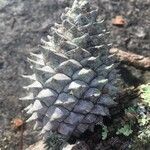Small, often crooked tree to 10(20) m, with widely spreading branches; lvs in 2’s or rarely some of them in 3’s, dark bluish-green, stiff, sharp, usually twisted, mostly 4–9 cm × 1.5–2 mm; cones spreading or deflexed, conic-ovoid, mostly 6–9 cm long-persistent, often remaining closed for several years or until fire; apophysis thick, strongly elevated at the center, the umbo pyramidally projecting, with a very stout, spreading or upwardly curved spine 3–8 mm; seeds ca 2 cm; male cones reddish-purple. Dry or rocky soil, chiefly in the mts.; Pa. and adj. N.J. to n. Ga. Readily recognizable by its strongly armed cones.


